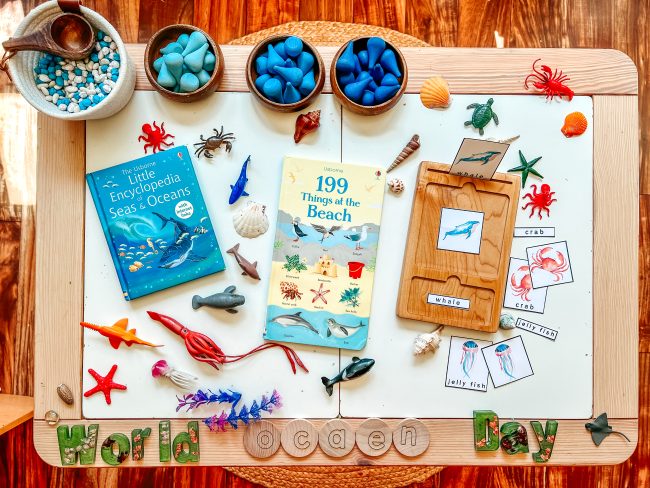
Designing a themed sensory play setup is one of the most rewarding ways to nurture your toddler’s curiosity and creativity. Sensory play engages all five senses, helping children explore, experiment, and learn about the world around them. By adding a theme—like “Under the Sea,” “Construction Zone,” or “Dinosaur Dig”—you can transform a simple activity into an immersive experience that sparks imagination and deepens learning. If you’re looking to boost your toddler’s curiosity, here’s a step-by-step guide to creating a themed sensory play setup.
Why Themed Sensory Play Matters
Themed sensory play setups go beyond basic entertainment.
They:
- Encourage language development as toddlers describe what they see, feel, and do.
- Foster problem-solving and critical thinking through open-ended exploration.
- Support fine motor skills by scooping, pouring, and sorting.
- Build social skills when shared with siblings or friends.
Most importantly, themed setups make learning fun and memorable, keeping your toddler engaged for longer stretches, perfect for busy parents who want meaningful, independent play.
Choose an Engaging Theme
Start by picking a theme that excites your child or relates to their current interests. Popular ideas include:
- Farmyard Adventure
- Outer Space
- Construction Site
- Ocean Exploration
- Jungle Safari
Let your toddler help choose the theme—they’ll be more invested and excited to play.
Select Your Sensory Base
The sensory base is the heart of your setup. Sensory beans are a fantastic choice: they’re colorful, tactile, and easy to clean up. You can use plain dried beans or dye them with food coloring for extra visual appeal. Other popular bases include rice, pasta, water beads (with supervision), or kinetic sand.
How to dye sensory beans:
- Place beans in a zip-top bag.
- Add a few drops of food coloring and a splash of vinegar or rubbing alcohol.
- Seal and shake until the color is distributed.
- Spread beans on a tray to dry before play.
Gather Themed Props and Tools
Props bring your theme to life and encourage imaginative play.
For example:
- Under the Sea: Small plastic sea animals, shells, blue and green beans, scoops, and cups.
- Construction Zone: Toy trucks, mini cones, rocks, yellow and brown beans, small shovels.
- Dinosaur Dig: Plastic dinosaurs, faux leaves, brown and green beans, magnifying glass, small brushes.
Include a variety of tools—spoons, tongs, cups, and funnels—to promote fine motor development and offer different ways to interact with the beans.
Set Up a Safe and Inviting Play Space
Choose a location that’s easy to clean, like a kitchen floor or a washable play mat. Use a large, shallow bin or tray to contain the sensory beans and props. Place a mat or sheet underneath to catch stray beans and make cleanup easier. Arrange the props and tools around the bin, inviting your toddler to explore. Keep the setup at their height for easy access and independence.
Introduce the Activity and Model Play
Sit with your toddler and introduce the theme. Use simple language to describe the setup: “Today, we’re going to explore the ocean! Let’s see what animals we can find in the beans.” Model how to use the tools and interact with the props, then step back and let your child take the lead. Encourage them to describe what they’re doing, ask questions, and invent stories. This not only boosts language skills but also nurtures curiosity and creativity.
Extend the Learning
Themed sensory play is a springboard for deeper learning.
Try these ideas:
- Storytime: Read a book related to your theme before or after play.
- Art projects: Create crafts that match the theme, like painting sea creatures or building paper rockets.
- Science experiments: Add water to see how beans float or sink, or use magnets with metal props for a construction theme.
Rotate themes regularly to keep things fresh and align with your toddler’s evolving interests.
Safe Storage and Cleanup
When playtime is over, involve your toddler in cleanup. Use a small broom or hand vacuum to collect stray beans. Store sensory beans in a labeled, airtight container for future use—most beans can be reused for months if kept dry.
Tips for Success
- Always supervise young children, especially if they’re still mouthing objects.
- Use only non-toxic, food-safe materials.
- Limit the number of props at first to avoid overwhelming your toddler.
- Encourage open-ended play—there’s no right or wrong way to explore!
Creating a themed sensory play setup is a wonderful way to boost your toddler’s curiosity, encourage independent exploration, and support early learning. So gather your beans, pick a theme, and watch your toddler’s imagination soar.